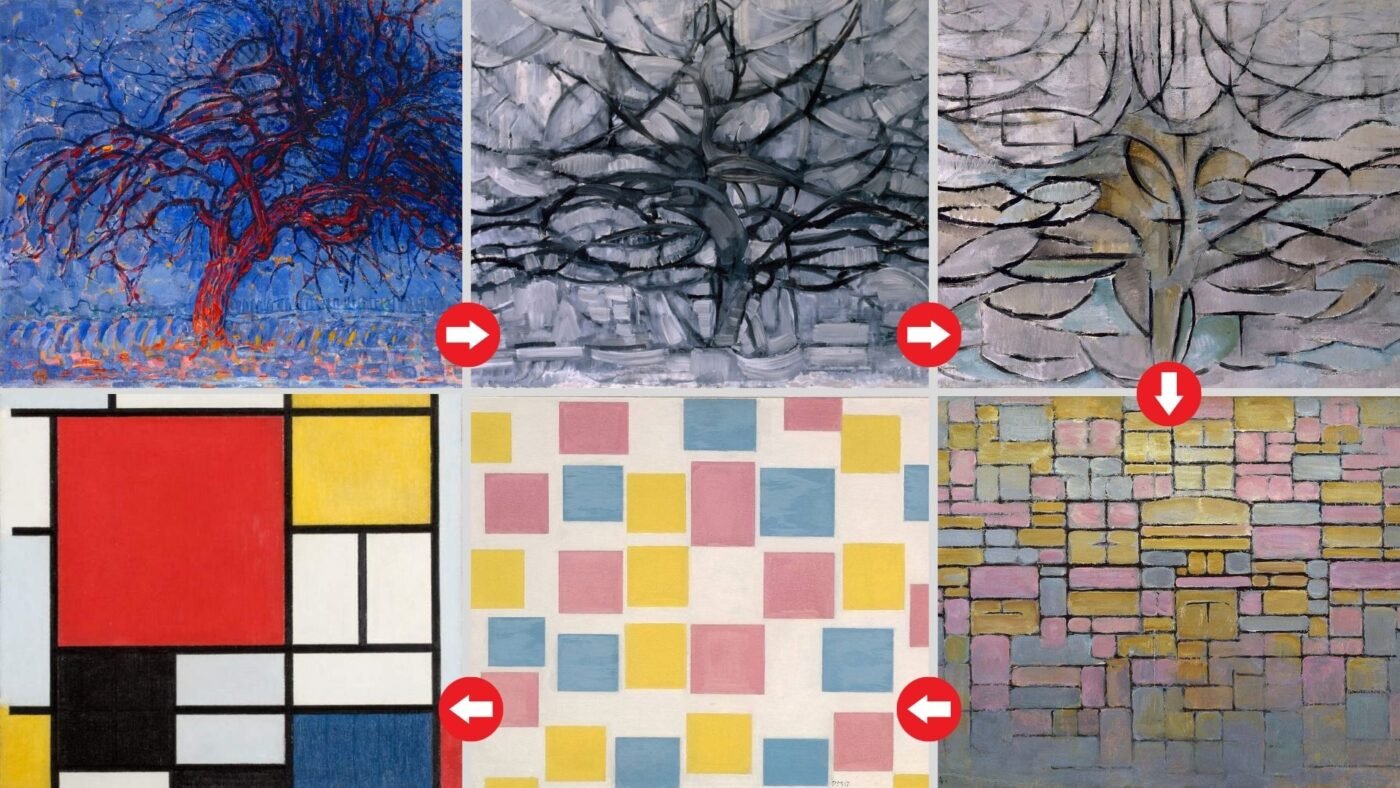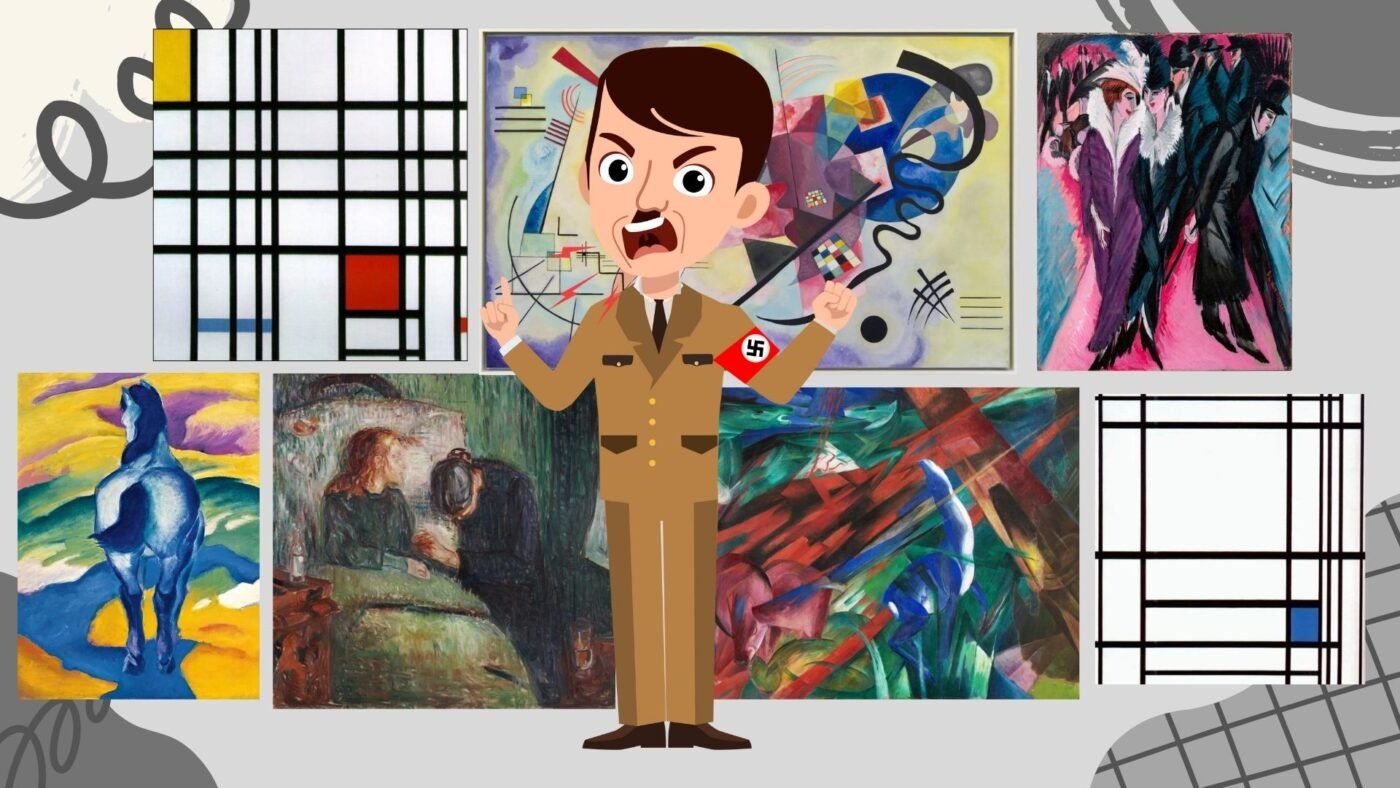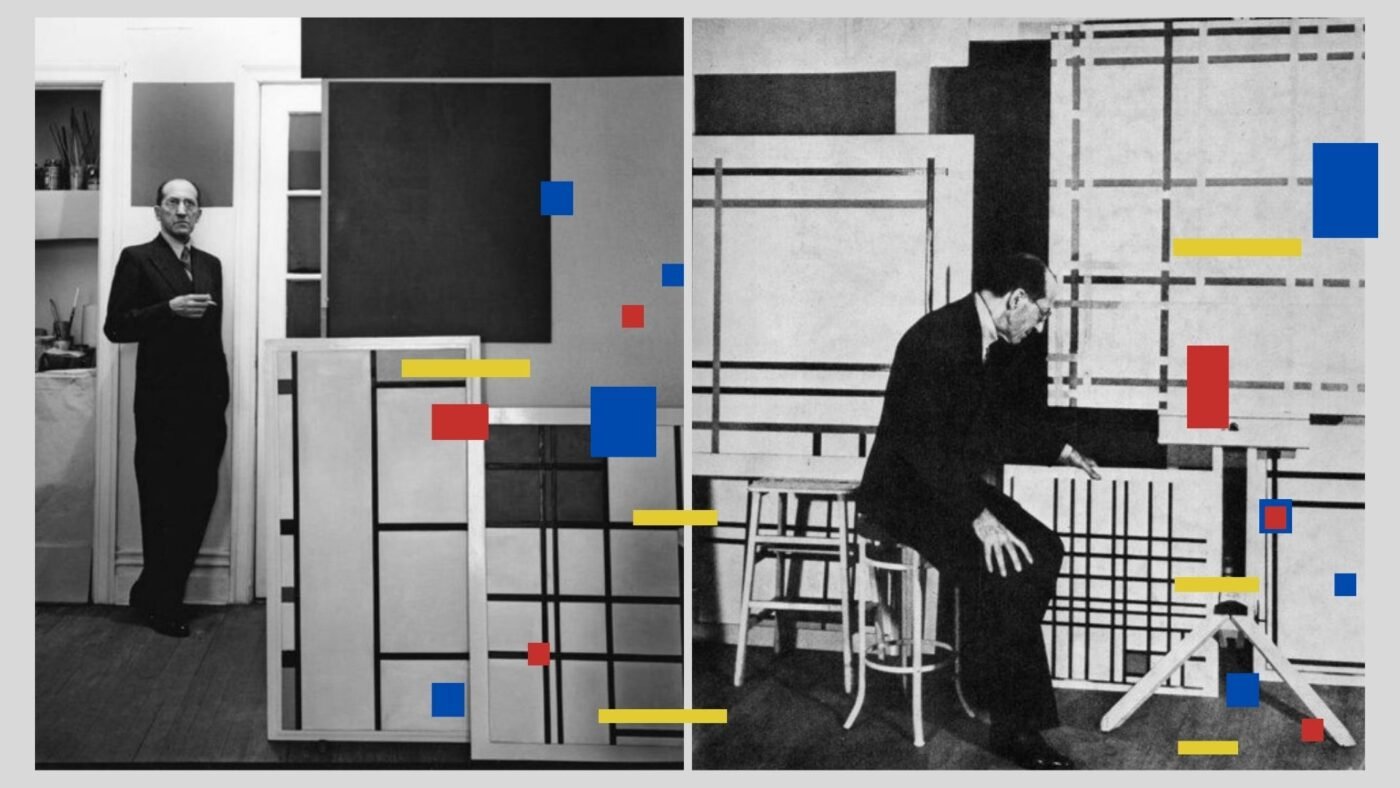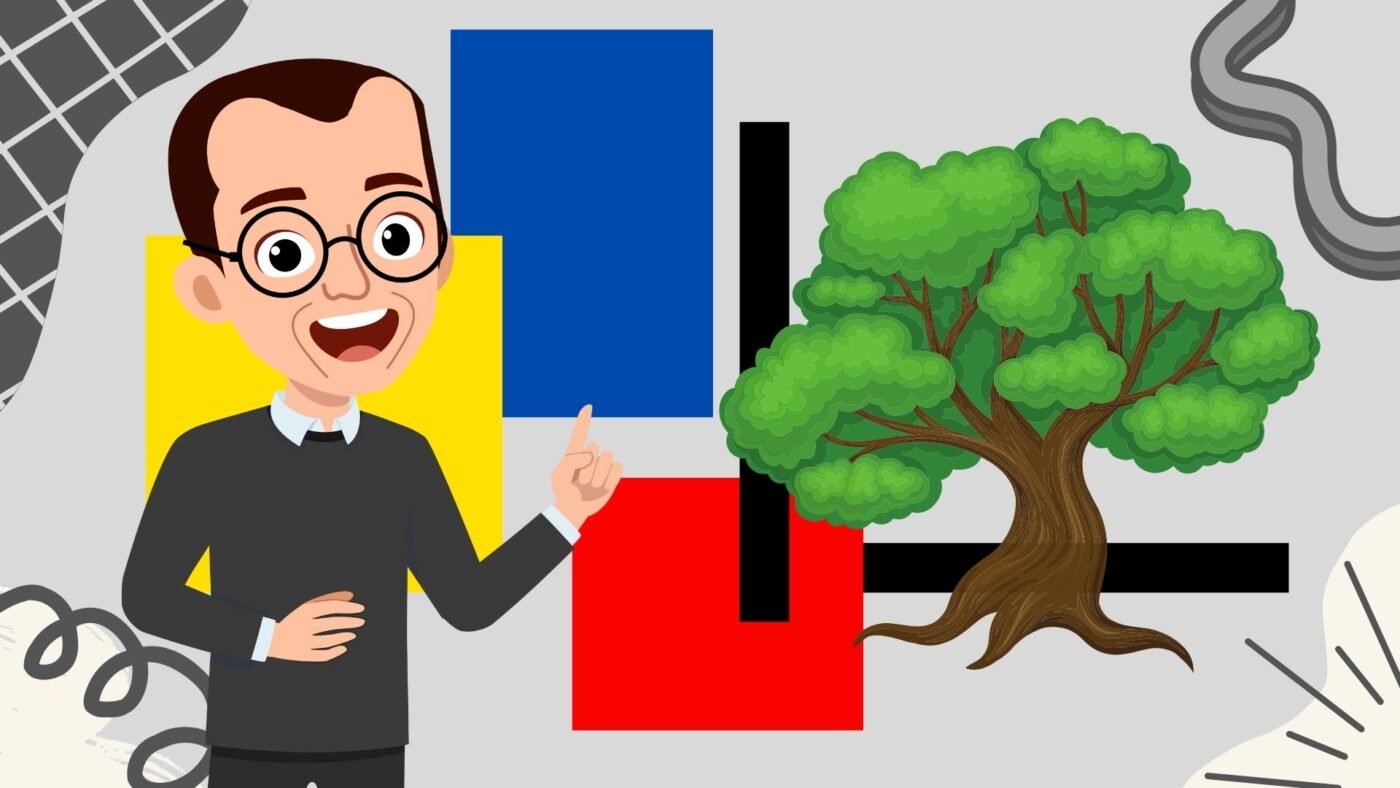No products in the basket.
Art History
Artist Piet Mondrian – Modern Art Explained by Lillian Gray
Piet Mondrian’s influence is profound, reaching well beyond the realm of painting. His contributions to abstract art, the De Stijl movement, and his innovative use of form and colour have profoundly impacted the art world, design, architecture, and popular culture.
Watch our video on Piet Mondrian on YouTube now.
What if I asked you to draw a tree? What would you draw, something like this?
Now, I want you to draw the feeling of a tree. You are not allowed to draw a physical tree or anything representing real life. You need to consider what a tree feels like to you. I want you to draw the emotion. Do trees make you feel happy, safe, and calm? Maybe you once fell out of a tree, and now they make you anxious. Whatever you are feeling, how would you draw it? How would you depict that on a page?
Now, that is much harder.
Often, we walk into Modern Art Galleries and think, “Look at this! My 4-year-old little sister could draw that!” And that’s mainly because we do not understand the thought process behind the art.

Let me ask you this: “Is this a tree?”
Well, no. It is a picture of a tree. It’s not really a tree. It is an illusion of a tree. As artists, we often take a 3D object from life and represent it on a 2D surface. We create the illusion of the actual object. We add our own thoughts, way of thinking and seeing into our art, adding our perspective to the work. As artists, it is essential to be aware of this process and how it works. Many steps involve seeing an object and then drawing or painting it.
Is this a tree?
According to the Dutch artist Piet Mondrian, it is. It is his painting of a tree, his interpretation.
He developed a new art movement called De Stijl, which was all about a new way of depicting the world. It wasn’t about depicting the actual object but rather capturing the feeling and balance of the object.
He took an object and then…
Simplified. Simplified. Simplified and Simplified it to its utter core. Eventually, it simplified everything into only primary colours, red, blue and yellow, with horizontal and vertical black lines.

It took years of work and abstract thought to arrive at this method. Today, Mondrian is celebrated for these artworks, but arriving here has been quite a journey. He is known for his primary colour block paintings, but we have 280 paintings by Piet Mondrian that aren’t abstract at all. They are landscapes.
Two hundred eighty attempts before his art finally started morphing into something that changed the world forever!

So buckle up and settle down as I share the story of Dutch artist Piet Mondrian and his revolutionary art.
Oh, and by the way, I’ve got some awesome worksheets related to Piet Mondrian available in my TpT Store. They’re are loads of fun, so make sure to check them out!
Mondrian was born in Amersfoort in the Netherlands into a very religious family. It was a childhood filled with heartache since his mother was often sick and his dad was super strict.

As a young man, Mondrian dreamed of becoming a famous artist. He did Biblical prints and painted landscapes but in a very different way from the other Dutch landscape artists. He wanted to be a famous artist like Rembrandt, who was also Dutch. He had this photo taken of himself in his studio to market his work and did a self-portrait, much like Rembrandt. All so that people would consider him a great artist.
In his quest to become a famous artist, he often visited Art Exhibitions to see what other contemporaries were painting.
At an exhibition, Mondrian saw Dutch artist Van Gogh’s work, and he loved it. He started incorporating Van Gogh’s line work and used dark blue lines in his landscapes.
Fauvism also inspired Mondrian. He experimented with their style and incorporated their bright, intense colours into his landscapes.

Soon, Mondrian realised that the centre of the art world at the time was Paris, and he dreamed of going and meeting Picasso. So, in 1911, Mondrian set off and moved to Paris. He saw Picasso’s and George Braque’s art, and he was simply fascinated by their work.
You see, those two artists were busy with a new movement called Cubism. Cubism was all about depicting one object from various angles on one canvas. So, the artwork can look messy, but it is all about the thinking behind the work. Unfortunately, I don’t have enough time to explain Cubism to you in this video. But what is important to know for now is that since the movement was all about a way of thinking, they had no use for colour. The works are predominantly painted in dark earth tones. Mondrian was fascinated by how they used the black lines in their artwork. The lines become a framework for shapes, almost like a skeleton with colour panes hanging in between the lines. Here, we can clearly see how Mondrian was influenced by the Cubists.

Mondrian has always been fascinated by trees and especially the negative space between the branches and the sky. The Negative spaces between the branches become more important than the tree itself, and the names of the paintings start changing.
In I914, Mondrian hears that his father is sick, so he returns to the Netherlands to visit him, and something terrible happens. World War 1 breaks out, and Piet Mondrian becomes trapped in the Netherlands. He cannot leave his country. However, it was during this time that he started his most remarkable work. He met a group of artists, one being Theo van Doesburg and the other Gerrit Rietveld. Together, they started a new art movement called De Stijl. In Dutch, this simply means The Style. And this art movement, De Stijl, changed our world forever!

It completely revolutionised architecture, product design, interior decorating and art. Piet Mondrian was instrumental in the theory and thinking behind the movement. He called his way of thinking New Plasticism.
It is about stripping an object down to only its essential essence. Depicting the world in a more abstract way is more beautiful and harmonious than reality.
During this time, the war was raging on, and World War 1 was horrible; over 40 million people died. Mondrian wanted to create a better world. A world filled with beauty, peace and balance. He believed art could change the world and prevent further wars.
Was he successful? Sadly not. We still have wars. Humans simply cannot stop fighting. However, what Mondrian and his artist friends created had a lasting effect on our modern world. It basically kickstarted Modern Art and architecture as we know it today.
The Rietveld-Schroder House, designed by Dutch architect Gerrit Rietveld in 1924, is considered a groundbreaking example of De Stijl’s architecture and Mondrian’s New Plasticism thinking. When you look at this house, I want you to remember that it is 100 years old! It still feels so modern. It consists of straight, clean lines. I don’t believe there are any curves in this house. The top floor is designed for open-plan living, which was revolutionary then. It also has stack-away walls to transform an open space into partitioned bedrooms. Rietveld intentionally used asymmetry in the design, challenging traditional notions of balance and symmetry in architecture. Rietveld also designed furniture for the house, such as the iconic Red and Blue Chair, which complemented the overall design aesthetic. So you can realise just how revolutionary this all was. Let’s compare this to a traditional Dutch chair of the time.
Unfortunately, the De Stil artists had a fight. Rumour has it that van Doesburg wanted to include a diagonal line, and Mondrian would have none of it! He simply decided he could no longer work with van Doesburg.
1919, World War 1 ended, and Piet Mondrian could return to his beloved Paris. In Paris, he created some of his most famous grid paintings and keeps on working on his simplification process. By now, all reality was removed from Piet Mondrian’s art. He strived to depict the ideal balance and harmony of life. People started visiting his studio and were amazed at the minimalist interior. His writings about art became quite famous and influenced the Bauhaus Movement back in Germany.
Mondrian loved the famous swirls of Van Gogh. He wanted people’s eyes to move in a similar way around his canvasses. So he created this rhythm in his works, where your eye moves clockwise around the grid paintings.
As Mondrian pushed himself in his art and thinking, Europe quickly became a dangerous place for free-thinkers and artists. During this time, the Nazi Party, led by Adolf Hitler, rapidly gained popularity. Eventually, Hitler declared war and started conquering Europe. Now you see, Hitler hated modern art and the freedom of thought that came with it.

Hitler himself was a rejected artist. He applied to the Vienna School of Art twice. He was told instead to try architecture. You see, Hilter’s art wasn’t cutting-edge enough; he was like a human printer. They wanted him to be more free-thinking like the German Expressionists, who were popular at the time. Still holding a grudge, Hitler and his party really clamped down on the modern art movements.
The Degenerate Art Exhibition was organised by the Nazis in Munich in 1937. The exhibition aimed to vilify and condemn modern art forms that did not conform to Nazi ideals of Aryan purity. The Nazis labelled these artworks as “degenerate” and sought to undermine their value and influence.
The exhibition featured works by artists such as Pablo Picasso, Wassily Kandinsky, Marc Chagall and Piet Mondrian, among others. The intention was to mock and ridicule the artists and their work. Many of the artworks were confiscated from museums and collections, and some were even destroyed.
Once again, Mondrian is trapped by war, but this time, he decides to flee. He moved to London in 1938 to escape all the tension in Paris. However, a bomb fell on the house where he stayed in London. He decides it would be best to leave for America as soon as possible. In September 1940, he set sail for America and moved to New York.

Various artists started to flee from Nazi Controlled Europe to America. The United States was seen as a safe haven for intellectual and creative freedom. In America, artists found supportive communities in cities like New York, which became a hub for artistic innovation and collaboration.
When Mondrian saw New York, he simply fell in love. He loved the hustling and the bustling and the Jazz Music. Mondrian even loved the New York Traffic. Maybe it was New York’s grid system that appealed to Mondrian’s love of order. The city was alive at night, which was a stark contrast to London’s darkened streets to avoid air raids.

Mondrian decided to depict New York using his abstract thinking. In his new body of work, we see the black lines fall away, and the colour lines run over each other. He also depicted the feeling and rhythm of Jazz music in his famous painting Broadway Boogie Woogie. Here, the black lines fall away, and the colour lines run over each other. Broadway Boogie Woogie was a popular dance at the time.
Sadly, Mondrian died only after three and a half years in New York of Pneumonia.
Now that you know the story and have seen the artwork, I bet you are wondering how he made these paintings.
Piet Mondrian’s Painting Technique
Did he use a ruler? Well no. His studio looked more like a laboratory than a typical messy creative space. It was spotless and precise and just as ordered as his paintings. He planned the lines in his paintings using a pencil and used his own version of masking tape to paint the lines. Looking at his canvases up close, you can see the ridge the paint formed at the edge of the tape.

Later, in New York, the first version of Masking Tape was released, and Mondrian wanted to be seen as a cutting-edge artist who used the latest technology to create art, so he went out and bought stacks of these gummi tape roles. In some of his last artwork, he even used the tape as a part of his artwork. The little pieces of tape are embedded into the lines. Mondrian had no patience with oil paint’s drying time. Looking at the squares closely, you can see millions of little brush strokes to make the shapes solid. He was clearly fiddling. Since he had no patience, he did something a bit stupid. He added petroleum to the paint so it could dry quickly.
This is a big no-no if you want a painting to last forever. Today, the paintings are flaking and cracking and a nightmare for museums to preserve. It is ironic since Mondrian never wanted to frame his paintings. He didn’t want to cage them in. He wanted them to bleed freely into the space and wanted people to imagine them expanding all over the walls and floors. Sadly, now museums have to frame his work since it’s so hard to keep the work protected with all the cracks and potential flakes.
Regardless of the damage, these artworks changed the world.
Piet Mondrian’s massive influence
Today, the influence of Piet Mondrian extends far beyond his paintings. You can find Piet Mondrian-inspired shoes, watches, handbags, and coats on the market. You can even live in a Piet Mondrian-inspired house…how cool is this interior….and ooh, look at this one; it glows.
His works have been in movies, on runways, in magazines, on album covers, adverts and on posters. He is everywhere!
Yet, it’s essential to recognise that Mondrian’s legacy isn’t about slapping primary colours and black lines onto everything. The thinking matters– the idea that we should strip away excess and distil everything to its essence. This philosophy results from years of refinement, focusing on what’s essential and eliminating the superfluous. By doing so, we can appreciate true beauty and harmony.

His emphasis on minimalism and simplicity helped shape our modern world. As a founding member of the De Stijl movement, Mondrian revolutionised modern living. His contributions extend far beyond the canvas, leaving an indelible mark on art, design, architecture, and popular culture.
Today, Mondrian is celebrated as one of the pioneers of abstract art. His signature style contributed to the development of non-objective painting, where the emphasis is on form, colour, and composition rather than representing recognisable objects.
I want you to remember that Piet Mondrian’s abstract style was a journey that spanned over the years. He painstakingly crafted his abstract style. He delved deep into the works of various artists, tirelessly experimenting with a multitude of art styles, all in pursuit of nurturing his own unique, original ideas.
In summary, Piet Mondrian’s influence is profound, reaching well beyond the realm of painting. His contributions to abstract art, the De Stijl movement, and his innovative use of form and colour have had a profound and enduring impact on the art world, design, architecture, and popular culture.
I am artist Lillian Gray and I love teaching art and art history. If you liked this video, give it a thumbs up and drop a comment.
Until Next time.
BUY OUR PIET MONDRIAN WORKSHEETS
Worksheet pack that includes notes and fun activities. Ideal for art students and history students to learn more about Piet Mondrian and Abstract art.

